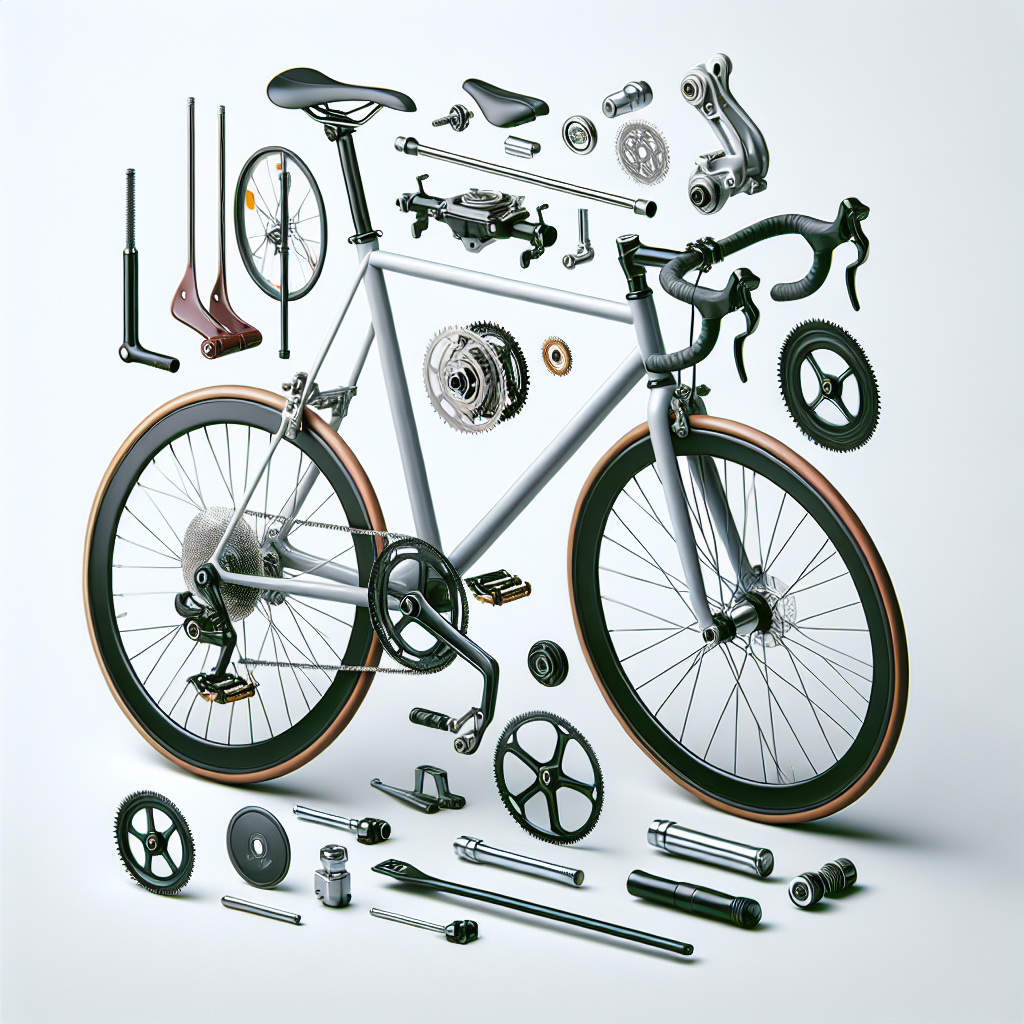
Bicycles are intricate machines composed of numerous components, each playing a crucial role in ensuring a smooth and efficient ride. Understanding these essential bike components can help both novice and experienced cyclists maintain their bikes better and make informed decisions when upgrading or repairing their bicycles.
Frame
The frame is the backbone of any bicycle, providing the structure to which all other components are attached. Frames come in various materials, including steel, aluminum, carbon fiber, and titanium, each offering different benefits in terms of weight, strength, and ride quality.
Materials
- Steel: Known for its durability and comfort, steel frames are often heavier but provide a smooth ride.
- Aluminum: Lightweight and affordable, aluminum frames are popular for their stiffness and efficiency.
- Carbon Fiber: Extremely light and strong, carbon fiber frames offer excellent performance but can be more expensive.
- Titanium: Combining the best of both worlds, titanium frames are light, strong, and comfortable, though they come at a premium price.
Geometry
The geometry of a bike frame affects its handling and comfort. Key measurements include the top tube length, seat tube angle, and head tube angle. Different types of bikes, such as road, mountain, and hybrid, have distinct geometries tailored to their specific uses.
Wheels
Wheels are another critical component, influencing the bike’s speed, stability, and comfort. They consist of rims, spokes, hubs, and tires, each contributing to the overall performance.
Rims
Rims come in various materials and profiles. Aluminum rims are common for their balance of weight and strength, while carbon rims are favored in high-performance bikes for their lightweight and aerodynamic properties.
Spokes
Spokes connect the rim to the hub and play a vital role in maintaining wheel strength and stability. They can be made from steel, aluminum, or even carbon fiber, with different lacing patterns affecting the wheel’s performance.
Hubs
The hub is the central part of the wheel, housing the axle and bearings. High-quality hubs ensure smooth rotation and durability. There are different types of hubs, including quick-release and thru-axle, each offering unique benefits.
Tires
Tires come in various sizes and tread patterns, tailored to different riding conditions. Road bike tires are typically narrow and smooth for speed, while mountain bike tires are wider with aggressive treads for better grip on rough terrain.
Drivetrain
The drivetrain is responsible for transferring power from the rider to the wheels, enabling movement. It includes components such as the crankset, chain, cassette, and derailleurs.
Crankset
The crankset consists of the crank arms and chainrings. It converts the rider’s pedaling motion into rotational force. Cranksets come in various configurations, including single, double, and triple chainrings, each offering different gear ranges.
Chain
The chain is a crucial link in the drivetrain, connecting the chainrings to the cassette. Chains need regular maintenance, such as cleaning and lubrication, to ensure smooth operation and longevity.
Cassette
The cassette is a cluster of sprockets attached to the rear wheel hub. It provides different gear ratios, allowing the rider to adjust their pedaling effort according to the terrain. Cassettes come in various sizes, with more sprockets offering a wider range of gears.
Derailleurs
Derailleurs are mechanisms that move the chain between different sprockets on the cassette and chainrings. There are front and rear derailleurs, each controlled by shifters on the handlebars. Proper adjustment and maintenance of derailleurs are essential for smooth and accurate shifting.
Brakes
Brakes are vital for safety, allowing the rider to control their speed and stop when necessary. There are several types of brakes, each with its advantages and disadvantages.
Rim Brakes
Rim brakes, such as caliper and cantilever brakes, work by applying friction to the wheel rims. They are lightweight and easy to maintain but can be less effective in wet conditions.
Disc Brakes
Disc brakes use a rotor attached to the wheel hub and calipers to provide stopping power. They offer superior performance in all weather conditions and are becoming increasingly popular in both road and mountain bikes.
Drum Brakes
Drum brakes are less common but offer excellent durability and low maintenance. They are typically found on utility and commuter bikes.
Handlebars and Controls
Handlebars and controls are essential for steering and controlling the bike. They come in various shapes and sizes, each suited to different riding styles and preferences.
Handlebars
Handlebars can be flat, riser, drop, or aero, each offering different hand positions and control. The choice of handlebars affects the rider’s posture and comfort.
Shifters
Shifters control the derailleurs, allowing the rider to change gears. They can be integrated with brake levers or separate, with different mechanisms such as trigger, twist, or electronic shifting.
Brake Levers
Brake levers are used to activate the brakes. They should be positioned for easy access and comfortable use. Some brake levers are integrated with shifters, providing a more streamlined setup.
Saddle and Seatpost
The saddle and seatpost are crucial for rider comfort and efficiency. The right saddle can make a significant difference in the overall riding experience.
Saddle
Saddles come in various shapes, sizes, and materials. The choice of saddle depends on the rider’s anatomy, riding style, and personal preference. A well-fitted saddle can prevent discomfort and injuries.
Seatpost
The seatpost connects the saddle to the frame and allows for height adjustment. Seatposts can be made from aluminum, carbon fiber, or titanium, with some offering additional features such as suspension for added comfort.
Pedals
Pedals are the interface between the rider and the bike, playing a crucial role in power transfer and control. There are different types of pedals, each suited to specific riding styles.
Flat Pedals
Flat pedals provide a large surface area for the rider’s foot and are commonly used in mountain biking and casual riding. They offer easy foot placement and quick release.
Clipless Pedals
Clipless pedals use a cleat system to attach the rider’s shoe to the pedal, providing a secure connection and efficient power transfer. They are popular in road and mountain biking for their performance benefits.
Conclusion
Understanding the essential components of a bicycle is crucial for maintaining and optimizing your ride. Each component plays a vital role in the overall performance and comfort of the bike. Whether you’re a casual rider or a seasoned cyclist, knowing your bike’s parts can help you make informed decisions and enjoy a better riding experience.

